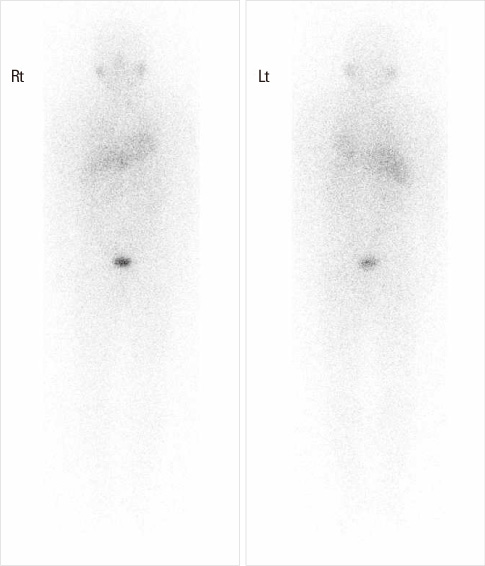Endocrinol Metab.
2012 Jun;27(2):159-162. 10.3803/EnM.2012.27.2.159.
A Case of Dopamine-Secreting Pheochromocytoma
- Affiliations
-
- 1Department of Internal Medicine, Catholic University of Daegu School of Medicine, Daegu, Korea. Jed15@cu.ac.kr
- 2Department of Pathology, Catholic University of Daegu School of Medicine, Daegu, Korea.
- KMID: 1497658
- DOI: http://doi.org/10.3803/EnM.2012.27.2.159
Abstract
- A pheochromocytoma is a neuroectodermal tumor that originates from the chromaffin cells of the sympathetic system. It has typical symptoms or signs, such as periodic attacks of paroxysmal hypertension, palpitation, headache, and sweating, related to an increased catecholamine secretion. Types of catecholamine secreted from tumors are usually norepinephrine and epinerphrine. There are a few reports of dopamine-secreting pheochromocytoma with absence of other catecholamines secretion. Here, we report the case of a 59-year-old man with dopamine-secreting pheochromocytoma, with no typical symptoms or signs.
Keyword
MeSH Terms
Figure
Reference
-
1. Ito Y, Fujimoto Y, Obara T. The role of epinephrine, norepinephrine, and dopamine in blood pressure disturbances in patients with pheochromocytoma. World J Surg. 1992. 16:759–763.2. Yasunari K, Kohno M, Minami M, Kano H, Ohhira M, Nakamura K, Yoshikawa J. A dopamine-secreting pheochromocytoma. J Cardiovasc Pharmacol. 2000. 36:Suppl 2. S75–S77.3. Dubois LA, Gray DK. Dopamine-secreting pheochromocytomas: in search of a syndrome. World J Surg. 2005. 29:909–913.4. Bartolacci M, Bartolacci S, Leombruni E, Annunziata A, Di Rienzo M, Picardi N. Adrenal incidentaloma: a dopamine-secreting pheochromocytoma with an atypical clinical picture. A case report and review of the literature. Ann Ital Chir. 1998. 69:805–814.5. Proye C, Fossati P, Fontaine P, Lefebvre J, Decoulx M, Wemeau JL, Dewailly D, Rwamasirabo E, Cecat P. Dopamine-secreting pheochromocytoma: an unrecognized entity? Classification of pheochromocytomas according to their type of secretion. Surgery. 1986. 100:1154–1162.6. Jain SK, Agarwal N. Asymptomatic giant pheochromocytoma. J Assoc Physicians India. 2002. 50:842–844.7. Minamiguchi N, Inui E, Nukui M. A case of dopamine-secreting pheochromocytoma. Hinyokika Kiyo. 1999. 45:831–833.8. Van Der Horst-Schrivers AN, Osinga TE, Kema IP, Van Der Laan BF, Dullaart RP. Dopamine excess in patients with head and neck paragangliomas. Anticancer Res. 2010. 30:5153–5158.9. van der Harst E, de Herder WW, Bruining HA, Bonjer HJ, de Krijger RR, Lamberts SW, van de Meiracker AH, Boomsma F, Stijnen T, Krenning EP, Bosman FT, Kwekkeboom DJ. [123I]metaiodobenzylguanidine and [111In] octreotide uptake in begnign and malignant pheochromocytomas. J Clin Endocrinol Metab. 2001. 86:685–693.10. Pacak K, Linehan WM, Eisenhofer G, Walther MM, Goldstein DS. Recent advances in genetics, diagnosis, localization, and treatment of pheochromocytoma. Ann Intern Med. 2001. 134:315–329.
- Full Text Links
- Actions
-
Cited
- CITED
-
- Close
- Share
- Similar articles
-
- Metanephrine negative pheochromocytoma: a rare case report of dopamine-secreting tumor in an adolescent neurofibromatosis type 1 patient
- A Case of Malignant Pheochromocytoma
- A Case of Pheochromocytoma Presented with Cardiogenic Shock and Followed by Spontaneous Remission
- Renovascular Hypertension Associated with Pheochromocytoma: A case report
- A Case of Calcitonin Secreting Pheochromocytoma




